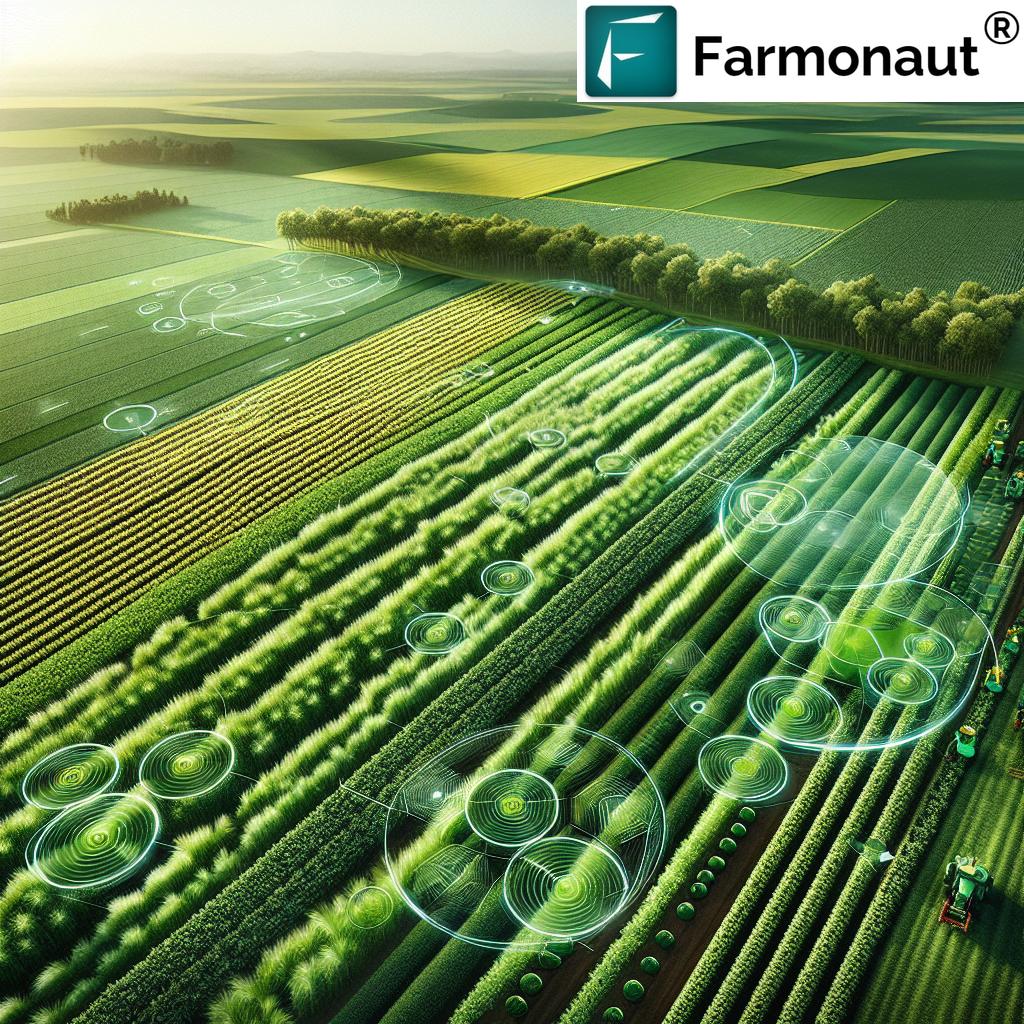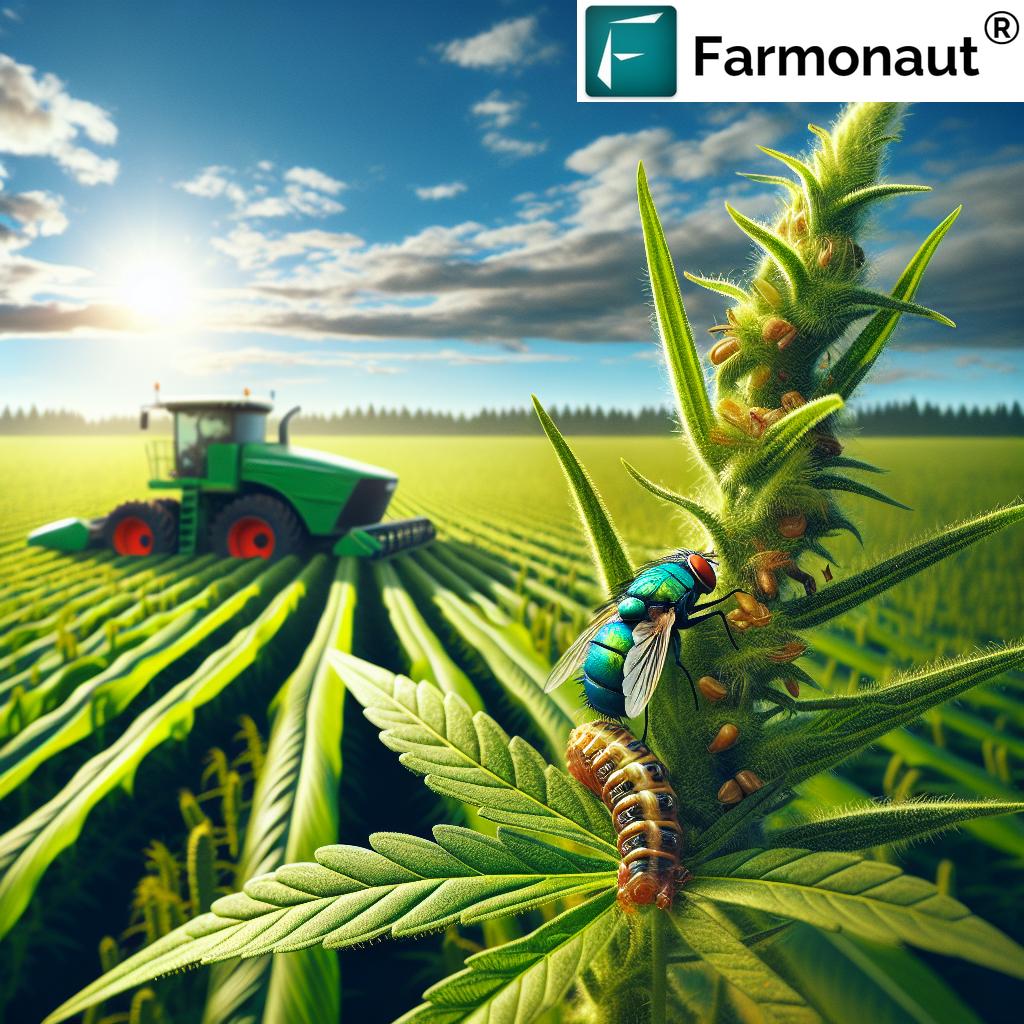Maximizing Oil Palm Yields: A Comprehensive Guide to Planting Density, Age, and Acre Productivity

In the world of agriculture, oil palm cultivation has emerged as a significant player, offering substantial economic benefits and contributing to global vegetable oil production. As experts in agricultural technology and precision farming, we at Farmonaut understand the importance of maximizing oil palm yields while maintaining sustainable practices. In this comprehensive guide, we’ll delve into the intricacies of oil palm cultivation, exploring crucial aspects such as planting density, yield variations by age, and productivity per acre.
Introduction to Oil Palm
The oil palm (Elaeis guineensis) is a remarkable tropical crop that has revolutionized the vegetable oil industry. Native to West Africa, this versatile palm species has been cultivated for thousands of years and has gained immense commercial importance in recent decades.
Key facts about oil palm:
- Oil palms are perennial crops with a productive lifespan of 25-30 years
- They produce two types of oil: palm oil from the fruit’s flesh and palm kernel oil from the seed
- Oil palms are the highest-yielding vegetable oil crop per unit area
- Major producing countries include Indonesia, Malaysia, Thailand, and Nigeria
The introduction of oil palm to commercial agriculture has had a profound impact on global food security and economic development in tropical regions. However, its cultivation also raises important environmental and sustainability concerns that must be addressed through responsible farming practices.
Planting Density: How Many Oil Palm Trees in 1 Acre?
One of the most crucial factors in oil palm cultivation is determining the optimal planting density. The number of oil palm trees in 1 acre can significantly impact overall yield and plantation management. While the exact number may vary depending on specific conditions and cultivation practices, here are some general guidelines:
- Standard planting density: 55-65 palms per acre (136-160 palms per hectare)
- High-density planting: Up to 80 palms per acre (200 palms per hectare)
- Low-density planting: As few as 40 palms per acre (100 palms per hectare)
The choice of planting density depends on various factors, including:
- Soil fertility and water availability
- Genetic characteristics of the planting material
- Management practices and mechanization level
- Environmental conditions and topography
At Farmonaut, we utilize advanced satellite imagery and AI-driven analytics to help farmers determine the optimal planting density for their specific conditions. Our Farmonaut app provides valuable insights into soil health, moisture levels, and other critical factors that influence planting decisions.
Oil Palm Yield by Age
Understanding the oil palm yield by age is crucial for effective plantation management and long-term planning. Oil palms have a distinct yield pattern throughout their productive lifespan:
- Years 1-3: Establishment phase with no significant yield
- Years 4-7: Rapidly increasing yield as palms mature
- Years 8-15: Peak production phase
- Years 16-25: Gradual decline in yield
- Beyond 25 years: Significant decrease in productivity, often leading to replanting
Here’s a more detailed breakdown of the oil palm yield by age:
| Age (Years) | Approximate Yield (Tons of Fresh Fruit Bunches per Hectare) |
|---|---|
| 3-4 | 5-10 |
| 5-7 | 10-20 |
| 8-15 | 20-30 |
| 16-20 | 15-25 |
| 21-25 | 10-20 |
It’s important to note that these figures are approximate and can vary based on factors such as genetic material, environmental conditions, and management practices.
Oil Palm Yield Per Acre
The oil palm yield per acre is a critical metric for assessing plantation productivity and economic viability. On average, a well-managed oil palm plantation can produce:
- 3-4 tons of crude palm oil per acre per year (7-10 tons per hectare)
- 0.3-0.4 tons of palm kernel oil per acre per year (0.7-1 ton per hectare)
These yields translate to approximately 15-20 tons of fresh fruit bunches (FFB) per acre annually during peak production years. However, it’s essential to understand that the palm oil yield per acre can vary significantly based on several factors:
- Age of the palms
- Genetic quality of planting material
- Soil fertility and management
- Climate and weather conditions
- Pest and disease control
- Harvesting efficiency

At Farmonaut, we leverage cutting-edge satellite technology and AI-driven analytics to help oil palm growers optimize their palm tree yield per acre. Our platform provides real-time insights into crop health, soil moisture levels, and potential stress factors, enabling farmers to make data-driven decisions that maximize productivity.
Maximizing Oil Palm Yields with Precision Agriculture
To achieve optimal oil palm yield per acre, modern plantations are increasingly turning to precision agriculture techniques. These advanced methods allow for more efficient resource use and targeted interventions, resulting in higher yields and reduced environmental impact.
Key precision agriculture strategies for oil palm cultivation include:
- Satellite-based monitoring: Regular satellite imagery analysis provides valuable insights into crop health, stress levels, and growth patterns across large plantations.
- AI-driven advisory systems: Advanced algorithms analyze multiple data points to provide personalized recommendations for fertilization, irrigation, and pest management.
- Precision fertilization: Site-specific nutrient management based on soil analysis and plant requirements optimizes fertilizer use and improves yield.
- Smart irrigation: Automated irrigation systems that respond to real-time soil moisture data ensure optimal water use efficiency.
- Early pest and disease detection: Remote sensing technologies help identify potential outbreaks before they become widespread, allowing for targeted interventions.
Farmonaut’s comprehensive platform integrates these precision agriculture techniques, offering oil palm growers a powerful tool to maximize their yields. Our satellite-based API and mobile apps for Android and iOS provide easy access to critical data and insights, empowering farmers to make informed decisions.
Farmonaut Satellite System vs. Drone and IoT-based Farm Monitoring
| Feature | Farmonaut Satellite System | Drone-based Monitoring | IoT-based Monitoring |
|---|---|---|---|
| Coverage Area | Large-scale (thousands of acres) | Limited (typically <1000 acres per flight) | Limited by sensor placement |
| Data Frequency | Regular updates (every 3-5 days) | As per flight schedule | Real-time, but limited locations |
| Initial Investment | Low (subscription-based) | High (equipment and training) | Moderate to high (sensors and network) |
| Operational Complexity | Low (cloud-based platform) | High (requires skilled operators) | Moderate (maintenance of sensors) |
| Weather Dependency | Low (can penetrate clouds) | High (affected by wind and rain) | Low (continuous operation) |
| Data Analysis | Advanced AI-driven insights | Requires separate analysis tools | Limited to sensor data |
Sustainable Oil Palm Cultivation Practices
While maximizing yields is crucial for economic viability, it’s equally important to ensure that oil palm cultivation is conducted sustainably. Here are some key practices that promote both high yields and environmental responsibility:
- Integrated Pest Management (IPM): Utilizing biological controls and targeted interventions to minimize pesticide use
- Soil Conservation: Implementing cover crops, terracing, and other erosion control measures to maintain soil health
- Water Management: Adopting efficient irrigation systems and rainwater harvesting to reduce water consumption
- Biodiversity Conservation: Maintaining wildlife corridors and preserving high conservation value areas within plantations
- Waste Reduction: Recycling palm oil mill effluent and empty fruit bunches as organic fertilizers
- Carbon Footprint Reduction: Implementing methane capture systems at palm oil mills and minimizing transportation emissions
Farmonaut’s platform supports these sustainable practices by providing detailed insights into resource utilization and environmental impact. Our carbon footprinting feature helps plantations track and reduce their emissions, contributing to more sustainable oil palm cultivation.
The Future of Oil Palm Cultivation
As global demand for vegetable oils continues to rise, the oil palm industry faces both opportunities and challenges. Future developments in the sector are likely to focus on:
- Genetic Improvement: Developing high-yielding, disease-resistant varieties that require fewer inputs
- Advanced Robotics: Automating harvesting and other labor-intensive tasks to improve efficiency
- Blockchain Integration: Enhancing traceability and transparency in the palm oil supply chain
- Climate Change Adaptation: Breeding more resilient varieties and implementing adaptive management strategies
- Circular Economy Approaches: Maximizing the utilization of by-products and waste streams
At Farmonaut, we’re committed to staying at the forefront of these developments, continuously enhancing our platform to meet the evolving needs of oil palm growers. Our developer documentation provides insights into how our API can be integrated into custom solutions for the oil palm industry.
FAQ Section
Q1: What is the average lifespan of an oil palm tree?
A: Oil palm trees typically have a productive lifespan of 25-30 years. After this period, yields generally decline to a point where replanting becomes economically viable.
Q2: How long does it take for an oil palm to start producing fruit?
A: Oil palms usually start producing fruit bunches around 3 years after planting. However, commercial harvesting typically begins in the 4th year.
Q3: What is the difference between crude palm oil and palm kernel oil?
A: Crude palm oil is extracted from the fleshy part of the oil palm fruit, while palm kernel oil is derived from the kernel or seed of the fruit. They have different fatty acid compositions and are used in various industries.
Q4: How often are oil palms harvested?
A: Oil palm fruit bunches are typically harvested every 10-14 days throughout the year, as the trees produce fruit continuously in tropical climates.
Q5: What are the main environmental concerns associated with oil palm cultivation?
A: The primary environmental concerns include deforestation, loss of biodiversity, greenhouse gas emissions from land-use change, and water pollution from mill effluents. Sustainable cultivation practices aim to address these issues.
Q6: How can Farmonaut’s technology help improve oil palm yields?
A: Farmonaut’s satellite-based monitoring system provides real-time insights into crop health, soil moisture, and potential stress factors. This enables farmers to make data-driven decisions on irrigation, fertilization, and pest management, ultimately leading to improved yields and resource efficiency.
Q7: Is oil palm cultivation suitable for small-scale farmers?
A: Yes, oil palm can be suitable for small-scale farmers, especially when they have access to appropriate technologies and support systems. Farmonaut’s affordable precision agriculture solutions can help small-scale farmers optimize their yields and compete more effectively in the market.
Conclusion
Maximizing oil palm yields while maintaining sustainable practices is crucial for meeting global vegetable oil demand and ensuring the economic viability of plantations. By understanding the factors that influence oil palm yield per acre, such as planting density, age-related productivity, and environmental conditions, growers can make informed decisions to optimize their operations.
At Farmonaut, we’re dedicated to empowering oil palm growers with cutting-edge technology and data-driven insights. Our comprehensive platform integrates satellite imagery, AI analytics, and precision agriculture techniques to help farmers achieve optimal yields while promoting sustainable practices.
To experience the benefits of Farmonaut’s advanced agricultural technology for your oil palm plantation, subscribe to our services today:
By leveraging the power of satellite technology and AI-driven insights, we can work together to create a more productive, sustainable, and resilient oil palm industry for the future.














In this blog, maximizing oil palm yields is explored through detailed insights on planting density, tree age, and acre productivity, offering valuable strategies for optimizing crop output and enhancing plantation efficiency.